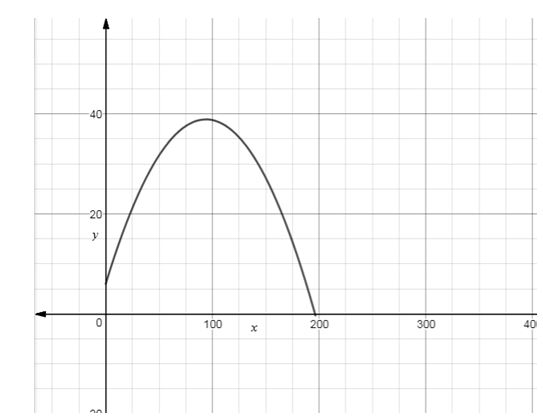
Concept explainers
To find:
a. Find parametric equations that model the position of the ball as a function of time.
Answer to Problem 43RE
a. ,
Explanation of Solution
Given:
Drew Brees throws a football with an initial speed of 80 feet per second at an angle of to the horizontal. The ball leaves Brees’ hand at a height of 6 feet.
Formula used:
Calculation:
a. ,
To find:
b. How long is the ball in the air?
Answer to Problem 43RE
b. seconds
Explanation of Solution
Given:
Drew Brees throws a football with an initial speed of 80 feet per second at an angle of to the horizontal. The ball leaves Brees’ hand at a height of 6 feet.
Formula used:
Calculation:
b. The ball is in air until .
The ball is in the air for about .
To find:
c. When is the ball at its maximum height? Determine the maximum height of the ball.
Answer to Problem 43RE
c. Maximum height of the ball: feet.
Explanation of Solution
Given:
Drew Brees throws a football with an initial speed of 80 feet per second at an angle of to the horizontal. The ball leaves Brees’ hand at a height of 6 feet.
Formula used:
Calculation:
c. The maximum height occurs at the vertex of the quadratic function.
seconds
feet
Maximum height of the ball is feet.
To find:
d. Determine the horizontal distance that the ball travels.
Answer to Problem 43RE
d. Horizontal distance: 196 feet.
Explanation of Solution
Given:
Drew Brees throws a football with an initial speed of 80 feet per second at an angle of to the horizontal. The ball leaves Brees’ hand at a height of 6 feet.
Formula used:
Calculation:
d. To determine the horizontal distance that the ball travels.
feet
To find:
e. Using a graphing utility, simultaneously graph the equations found in part a.
Answer to Problem 43RE
e. Graph is plotted.
Explanation of Solution
Given:
Drew Brees throws a football with an initial speed of 80 feet per second at an angle of to the horizontal. The ball leaves Brees’ hand at a height of 6 feet.
Formula used:
Calculation:
e. The graph of equation found in part a.

Chapter 10 Solutions
Precalculus Enhanced with Graphing Utilities
Additional Math Textbook Solutions
Basic Business Statistics, Student Value Edition
A First Course in Probability (10th Edition)
Elementary Statistics
Calculus for Business, Economics, Life Sciences, and Social Sciences (14th Edition)
Algebra and Trigonometry (6th Edition)
- The spread of an infectious disease is often modeled using the following autonomous differential equation: dI - - BI(N − I) − MI, dt where I is the number of infected people, N is the total size of the population being modeled, ẞ is a constant determining the rate of transmission, and μ is the rate at which people recover from infection. Close a) (5 points) Suppose ẞ = 0.01, N = 1000, and µ = 2. Find all equilibria. b) (5 points) For the equilbria in part a), determine whether each is stable or unstable. c) (3 points) Suppose ƒ(I) = d. Draw a phase plot of f against I. (You can use Wolfram Alpha or Desmos to plot the function, or draw the dt function by hand.) Identify the equilibria as stable or unstable in the graph. d) (2 points) Explain the biological meaning of these equilibria being stable or unstable.arrow_forwardFind the indefinite integral. Check Answer: 7x 4 + 1x dxarrow_forwardshow sketcharrow_forward
- Find the indefinite integral. Check Answer: 7x 4 + 1x dxarrow_forwardQuestion 1: Evaluate the following indefinite integrals. a) (5 points) sin(2x) 1 + cos² (x) dx b) (5 points) t(2t+5)³ dt c) (5 points) √ (In(v²)+1) 4 -dv ขarrow_forwardFind the indefinite integral. Check Answer: In(5x) dx xarrow_forward
- Find the indefinite integral. Check Answer: 7x 4 + 1x dxarrow_forwardHere is a region R in Quadrant I. y 2.0 T 1.5 1.0 0.5 0.0 + 55 0.0 0.5 1.0 1.5 2.0 X It is bounded by y = x¹/3, y = 1, and x = 0. We want to evaluate this double integral. ONLY ONE order of integration will work. Good luck! The dA =???arrow_forward43–46. Directions of change Consider the following functions f and points P. Sketch the xy-plane showing P and the level curve through P. Indicate (as in Figure 15.52) the directions of maximum increase, maximum decrease, and no change for f. ■ 45. f(x, y) = x² + xy + y² + 7; P(−3, 3)arrow_forward
 Calculus: Early TranscendentalsCalculusISBN:9781285741550Author:James StewartPublisher:Cengage Learning
Calculus: Early TranscendentalsCalculusISBN:9781285741550Author:James StewartPublisher:Cengage Learning Thomas' Calculus (14th Edition)CalculusISBN:9780134438986Author:Joel R. Hass, Christopher E. Heil, Maurice D. WeirPublisher:PEARSON
Thomas' Calculus (14th Edition)CalculusISBN:9780134438986Author:Joel R. Hass, Christopher E. Heil, Maurice D. WeirPublisher:PEARSON Calculus: Early Transcendentals (3rd Edition)CalculusISBN:9780134763644Author:William L. Briggs, Lyle Cochran, Bernard Gillett, Eric SchulzPublisher:PEARSON
Calculus: Early Transcendentals (3rd Edition)CalculusISBN:9780134763644Author:William L. Briggs, Lyle Cochran, Bernard Gillett, Eric SchulzPublisher:PEARSON Calculus: Early TranscendentalsCalculusISBN:9781319050740Author:Jon Rogawski, Colin Adams, Robert FranzosaPublisher:W. H. Freeman
Calculus: Early TranscendentalsCalculusISBN:9781319050740Author:Jon Rogawski, Colin Adams, Robert FranzosaPublisher:W. H. Freeman
 Calculus: Early Transcendental FunctionsCalculusISBN:9781337552516Author:Ron Larson, Bruce H. EdwardsPublisher:Cengage Learning
Calculus: Early Transcendental FunctionsCalculusISBN:9781337552516Author:Ron Larson, Bruce H. EdwardsPublisher:Cengage Learning





